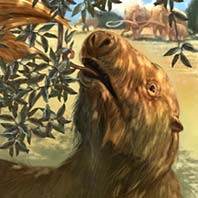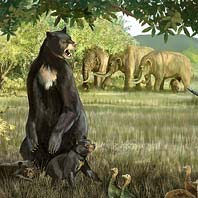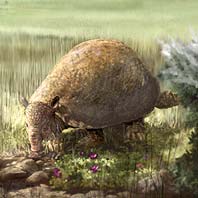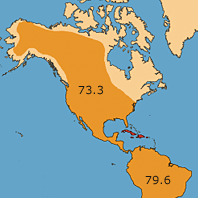|
Who or what snuffed out the mammoths and other megafauna 13,000
years ago?
It takes a certain kind of person to take on this question as his or
her life's work. You have to be itching to know the answer yet
patient as a Buddha, for the answer is frustratingly elusive. I know
I'm not the type. I'm intrigued by the question but far too anxious
to calmly accept, as some experts suggest, that it might be years or
decades, if ever, that a definitive, widely accepted solution
will come.
The three people I spoke to about the so-called megafaunal
extinctions possess this sort of edgy sangfroid. They also stand in
three decidedly different camps regarding why America's rich
complement of big animals went extinct quite suddenly at the end of
the Ice Age. The three camps are known tongue in cheek as
"overkill," "overchill," and "overill":
-
Archeologist Gary Haynes of the University of Nevada Reno thinks
that the continent's first human hunters, fresh from Siberia,
killed the big beasts off as they colonized the newly discovered
land.
-
Donald Grayson, an archeologist at the University of Washington,
Seattle, believes that climate changes at the end of the
Pleistocene epoch triggered the collapse.
-
And mammalogist Ross MacPhee of the American Museum of Natural
History has advanced the idea, with virologist Preston Marx,
that a virulent "hyperdisease" brought with the first people
might have raced through species with no natural immunity,
bringing about their demise.
Despite their differing views, these researchers sound remarkably
similar over the phone. Each is convincing about the merits of his
chosen hypothesis, even as he acknowledges its limitations. Each is
adamant as to the flaws that he thinks dooms one or both of the
other theories, even as he is gracious toward those who side with
that theory. Finally, each reveals that spark of deep passion for
the subject, and the choke needed to rein it for the long haul.
So why is the answer so elusive? As often happens in paleontology,
it all comes down to lack of empirical evidence, something all three
hypotheses arguably suffer from. (There's a fourth hypothesis,
actually—that a combination of overkill and overchill did it.)
 Overkill
Overkill

In the early 1960s ecologist Paul Martin of the University of
Arizona advanced the idea that the first Americans, who as every
schoolchild knows are thought to have crossed from Siberia to
America across the Bering Land Bridge, hunted the megafauna to
extinction. For many years, "overkill" became the leading contender.
The timing seemed more than coincidental: humans were thought to
have arrived no earlier than about 14,000 years ago, and by roughly
13,000 years ago, most of the megafaunal species abruptly vanish
from the fossil record. (See a
list of all 35 vanished genera
of North American Ice Age mammals.)
But some skeptics, Grayson among them, have asked where's the
evidence? Grayson and archeologist David Melzer of Southern
Methodist University have noted that late-Ice Age sites bearing
megafaunal remains that show unequivocal evidence of slaughter by
humans number just 14. Moreover, they stress, only two types of
giants were killed at those 14 sites, mammoth and mastodon. No signs
have turned up that early hunters preyed on giant ground sloths,
short-faced bears, camels, or any of the other large mammals that
went extinct. That's hardly enough evidence, they argue, to lay
blame for a continent's worth of lost megafauna at the foot of the
first Americans.
Gary Haynes begs to differ. "I don't care what anybody else says, 14
kill sites of mammoth and mastodon in a very short time period is
extraordinary," he told me. It's one thing to find a campsite with
some animal bones in it, he says, quite another to find the actual
spot where an animal was downed and butchered—where, say, a
spearpoint turns up still sticking in bone. "It's very, very rare to
find a kill site anywhere in the world," he says. And absence of
other megafauna in kill sites doesn't mean they weren't hunted.
"There is no doubt Native Americans were eating deer and bear and
elk," Haynes says, citing several megafauna that pulled through.
"But you cannot find a single kill site of them across 10,000
years."
Could what scholars agree must have been a relatively modest initial
population of hunters have emptied an entire continent of its
megafauna virtually overnight, geologically speaking? (In fact, it's
three continents: South America and, to a lesser extent, Northern
Eurasia also lost many large creatures at the end of the Ice Age.)
MacPhee, for his part, finds it hard to swallow. "I just don't think
it's plausible, especially if we're also talking about collapses for
megafauna that didn't actually go extinct." (Researchers have found
evidence that certain populations of surviving megafauna, including
musk oxen in Asia, fell precipitously at the end of the Ice Age.)
"It gets a little bit beyond probability in my view that people
could have been so active as to hunt every animal of any body size,
in every context, in every possible environment, over three
continents."
 Overchill
Overchill

Could climate change have done it? Scholars generally agree that
North America witnessed some rapid climate adjustments as it shook
off the Ice Age beginning about 17,000 years ago. The most
significant swing was a cold snap between about 12,900 and 11,500
years ago. Known as the Younger Dryas, this partial return to
ice-age conditions may have stressed the megafauna and their
habitats sufficiently to cause widespread die-offs, Grayson and
others believe.
Detractors, again, point to the lack of evidence. "There aren't any
deposits of starved or frozen or somehow naturally killed animals
that are clearly non-cultural in origin that you would expect if
there was an unusual climate swing," says Haynes. "I don't think
that evidence exists." Another question anti-overchillers have is
how the megafauna survived numerous glaciations and deglaciations
during the past two million years only to succumb to the one that
closed the Pleistocene.

The dearth of evidence doesn't deter researchers working in this
area. In fact, it's a spur.

MacPhee points to yet another problem: the geography of the
extinctions. For one thing, both North and South America suffered
them. "This is to me practically the most decisive evidence there is
that it could not have been what we conventionally think of as
climate change," he says. "If the entire continental part of the
Western Hemisphere was affected at roughly the same time, as good as
we can tell with the carbon-14 record, then what force of nature are
we talking about? The guys who support climate change are silent on
that point." And why was Africa spared? (Elephants, giraffes, and
many other African megafauna made it through just fine.) "There's
nothing that we know of in nature, climatically speaking, that works
in that fashion, as to affect one half of the world and not the
other," MacPhee says.
Grayson admits that overchill advocates have failed to develop the
kind of records that are needed to test climate hypotheses in
detail. But he focuses on climate change, he says, because he sees
absolutely no evidence that people were involved. "You can't look at
climate and say climate didn't do it for the simple reason that we
don't really know what to look for," Grayson told me. "But what you
can do fairly easily is look at the evidence that exists for the
overkill position. That position would seem to make fairly
straightforward predictions about what the past should have been
like, and when you look to see if it was that way, you don't find
it."
 Overill
Overill

Not finding supportive evidence has particularly plagued the
"overill" hypothesis. This is the notion that diseases brought
unwittingly by newly arriving people, either in their own bodies or
in those of their dogs or perhaps rats, could have killed off native
species that had no natural immunity. MacPhee devised this
hypothesis after realizing that the link between initial human
arrival and subsequent large-animal extinctions was strong not just
in North America but in many other parts of the world (see map at
right), but that in his opinion, convincing evidence for hunting as
the trigger simply did not exist.
Despite what he calls "prodigious effort" using DNA techniques and
immunological probes, however, MacPhee and his colleagues have
failed to detect clues to any pathogens in megafaunal bones, much
less nail down a specific disease, like rabies or rinderpest, that
could have jumped species boundaries and wiped out all the big
beasts. "[MacPhee's hyphothesis] doesn't even have circumstantial
evidence," says Haynes, "because we can't prove there was
hyperdisease. We can prove people were here, and we can prove
climates were changing." Fair enough, says MacPhee, though he points
out that the burgeoning ability of Asian bird flu to infect across
species boundaries seems to suggest that some diseases are
ecologically and genetically preordained to, as he puts it, "go
hyper."
 Soldiering on
Soldiering on

The dearth of evidence—seemingly significant in all three
camps—doesn't deter researchers working in this area. In fact,
it's a spur. MacPhee may be speaking for all scholars involved in
this famously contentious debate when he says: "What's of interest
here for me personally is that these Pleistocene extinctions have
occupied the minds of some very able thinkers over the last half
century or so, and nobody's come up with anything that's drop-dead
decisive. So it's attractive as an intellectual problem."
Granted. But hey, aren't you just dying to know what happened?


|


|
The giant ground sloth is just one of numerous large
mammals that vanished forever as the Ice Age wound down
in North America. The question is, Why?

|
|

|
No evidence has turned up that the giant short-faced
bear, the sabertooth cat, or any of the other extinct
big beasts shown in this painting (save for the
mastodon) were ever hunted by early Americans.

|
|

|
If climate change was the culprit, why didn't animals
like the now-vanished dire wolf (shown here menacing a
peccary) go extinct in any of numerous switches from
glacial to non-glacial conditions in the past two
million years?

|
|

|
Did a hyperdisease race through animals as diverse as
armadillo-like glyptodonts (above), mammoths, camels,
and cheetahs? The jury is still very much out.

|
|

|
This map shows how catastrophic animal extinctions
occurred around the world not long after humans first
arrived in a geographical region.
More to this caption

|
|
|

